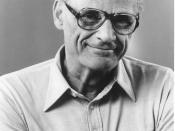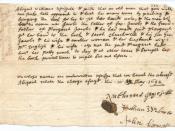"The Crucible: Motives of the Young Women"
In the early 1900's, witchcraft was a very serious issue, all considering that those caught practicing it would be put to death by being hanged. From this controversial time, comes a story, The Crucible, by Arthur Miller. It parallels the times of the McCarthy era. The hunt for communism and for communists of that time can compare to the witch-hunts in the book.
In The Crucible the group of girls, led by Tituba and Abigail that were caught dancing naked in the woods which were allegedly accused of practicing witchcraft, were never bewitched. They were just dancing around a fire pretending to cast spells upon the boys they loved, hoping that the boys would, in return, love them back. Shortly after, when one of the girls, Beth Parris, becomes sick, the rest of the girls are afraid that people will believe that witchcraft is occurring in the woods, and lead to them possibly being charged with witchery.
Because of their fears of being accused of practicing witchcraft, they start to say the names of others, accusing them of practicing witchcraft, in order to deflect attention from their sins. "Abigail starts the accusations by saying, "I go back to Jesus; I kiss his hand. I saw Sarah Good with the Devil! I saw Goody Osburn with the Devil! I saw Bridget Bishop with the Devil!" Another girl, Betty, continues the cry with her, "I saw George Jacobs with the Devil! I saw Goody Howe with the Devil!"" (McDowell).
Once Hale cleansed the girls from the grasp of the devil and into the open arms of Christ, the girls said that they were with God and that they loved Him. Because of this, they were seen as saved. Once they admitted to being taken over...



Lovely
A lovely essay, I liked the fact it was taken from the girls perspective. Great Work!
0 out of 0 people found this comment useful.